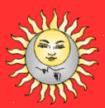


Nyasa -- divinity in the body
Mental worship is superior, and external worship is inferior. By worshipping Devata, a sadhaka is himself honoured - Niruttara TantraThe word Nyasa means placing and refers to a large component of tantrik ritualism in which the practitioner touches various parts of the body at the same time pronouncing a mantra and visualising a devata or a bija (root) mantra. Nyasa is supposed to "divinise" the body of the worshipper.
There are many types of nyasa, with some being very complex and elaborate. One example on this site is Mahashodha nyasa where a sadhaka or sadhvika places planets, constellations, sacred sites and other elements of Lalita's cosmology on her or his body. This demonstrates the identity of macrocosm and microcosm in the tantrik tradition.
The types of nyasa most often encountered in tantrika ritual are Rishi Nyasa, Kara (hand) Nyasa, Matrika Nyasa and Sadanga Nyasa. Every mantra has a Rishi or seer who first pronounced the mantra, thus giving birth to a line. According to many tantrik texts, using mantras which you take from books is fruitless, although this rule does not hold for Mahachinachara and, say some, the worship of Shri Shri Kali.
Matrika Nyasa is a form where the 50 letters of the Sanskrit alphabet are placed on the body. As this is done, the practitioner uses various hand gestures (mudras). The letters are prefixed with Om and suffixed with namah.
Sadanga Nyasa uses bijas connected with long vowels of the Sanskrit alphabet. Again, there are many examples here on this site.
The worship of different devatas introduces forms of Nyasa tailored to the particular divinity. For example, in the ritual worship of Bala, there are optional forms such as the Nine Yoni Nyasa, relating to the nine triangles in her yantra and an Arrow Nyasa, related to the five flowering arrows she holds in one of her hands.
And in the worship of Jvalamukhi, there is a very extended Nyasa which relates to the 21,600 breaths a human being takes in a day and a night. This is related to the position of the chakras within the human frame.
The worship of Kali is very ancient and there are hundreds of forms of related Nyasas. In an appendix to the Guhyakali section of the Mahakalasamhita, we find a multitude including Kalikulakrama Nyasa, Yogini Nyasa, Yajnamaharaja Nyasa, &c. &c.
Artwork is © Jan Bailey, 1995. Translations are © Mike Magee 1995. Questions or comments to [email protected]
Back to the Home Page.